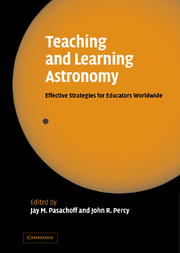Book contents
- Frontmatter
- Contents
- List of illustrations
- Preface
- Introduction
- Part I Astronomy in the curriculum around the world
- Part II Astronomy education research
- Part III Educating students
- Part IV Educating teachers
- Introduction
- 10 Pre-service astronomy education of teachers
- 11 In-service astronomy education of teachers
- Poster highlights
- Part V Astronomy and pseudoscience
- Part VI Astronomy and culture
- Part VII Astronomy in developing countries
- Part VIII Public outreach in astronomy
- Part IX The education programs of the International Astronomical Union
- Part X Conclusions
- Author index
- Subject index
10 - Pre-service astronomy education of teachers
Published online by Cambridge University Press: 18 May 2010
- Frontmatter
- Contents
- List of illustrations
- Preface
- Introduction
- Part I Astronomy in the curriculum around the world
- Part II Astronomy education research
- Part III Educating students
- Part IV Educating teachers
- Introduction
- 10 Pre-service astronomy education of teachers
- 11 In-service astronomy education of teachers
- Poster highlights
- Part V Astronomy and pseudoscience
- Part VI Astronomy and culture
- Part VII Astronomy in developing countries
- Part VIII Public outreach in astronomy
- Part IX The education programs of the International Astronomical Union
- Part X Conclusions
- Author index
- Subject index
Summary
Abstract: Although teachers are prepared in various ways to teach science, depending on the certification standards of their locality and the level at which they plan to teach, few are formally prepared to teach astronomy. In the United States, although astronomy is required for National Science Teacher certification in Earth/Space Science, and recommended for Physical Science, few teachers attempt this certification. Some certification degree programs require or recommend an astronomy course, but it is often at the introductory, non-science major level, or several weeks of astronomy within a science methods course for future elementary schoolteachers. The situation in other countries is no better. In Mexico, essentially no astronomy is taught except at the graduate school level. In South Africa, it is not taught at any teachers' college and only at some of the universities. In Portugal, it is not part of teacher preparation. In many countries, Earth-sun relations appear in the geography curriculum, but the remainder of astronomy is ignored in teacher preparation. In summary, although astronomy is found in some school curricula, teachers are often not formally prepared to teach it.
Unlike other topics in astronomy or education, there is very little research specifically on pre-service astronomy education. Perhaps it is because so few teachers are called upon to teach astronomy specifically, or because their astronomy teaching is peripheral to their main interest (e.g., general science at lower levels or physics at higher levels). Previous IAU meetings have had little information on this topic. The 1988 IAU Colloquium 105 on the Teaching of Astronomy (Pasachoff and Percy, 1990) had no papers on this topic.
- Type
- Chapter
- Information
- Teaching and Learning AstronomyEffective Strategies for Educators Worldwide, pp. 139 - 145Publisher: Cambridge University PressPrint publication year: 2005
- 2
- Cited by

